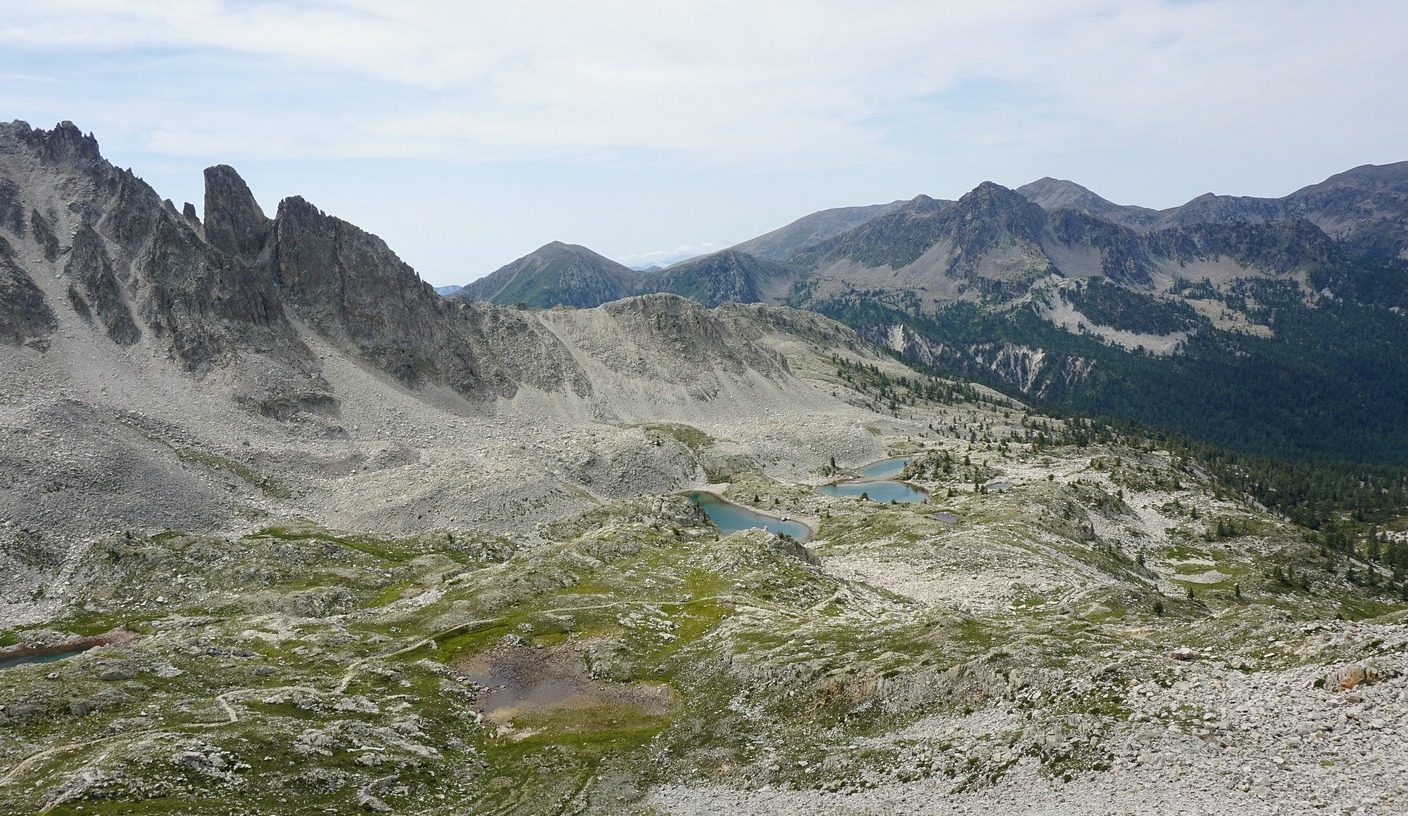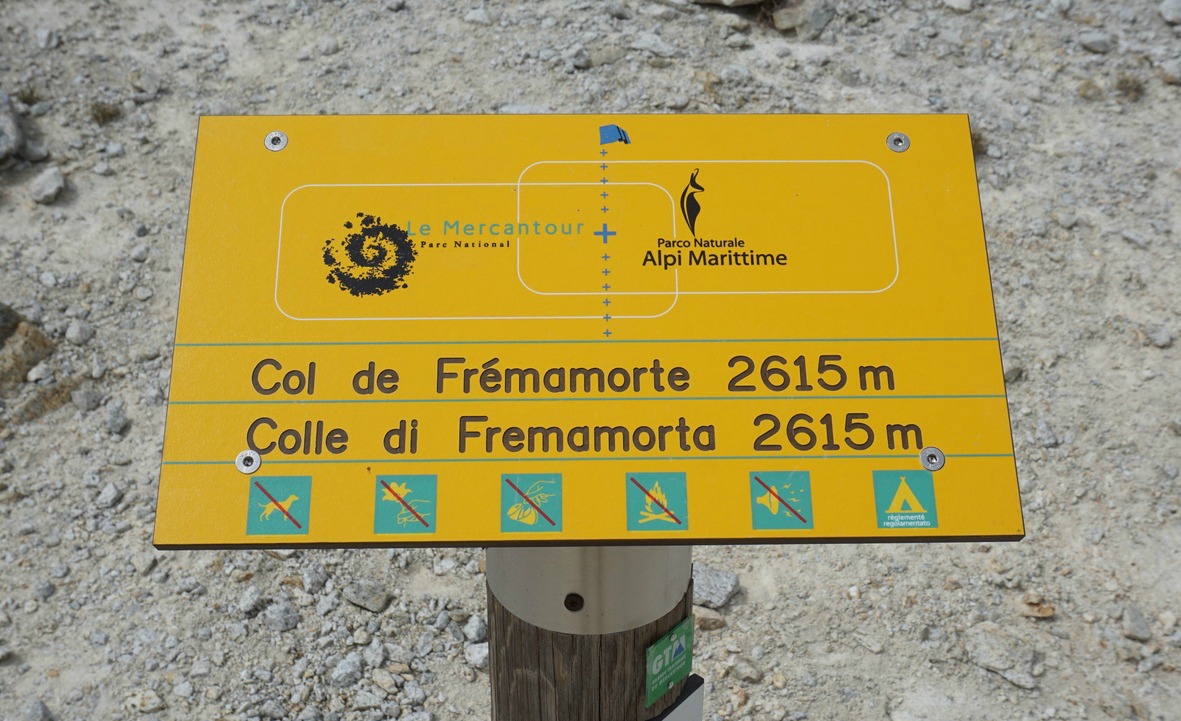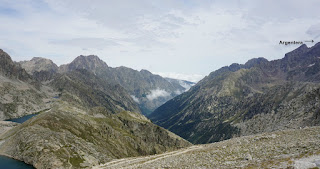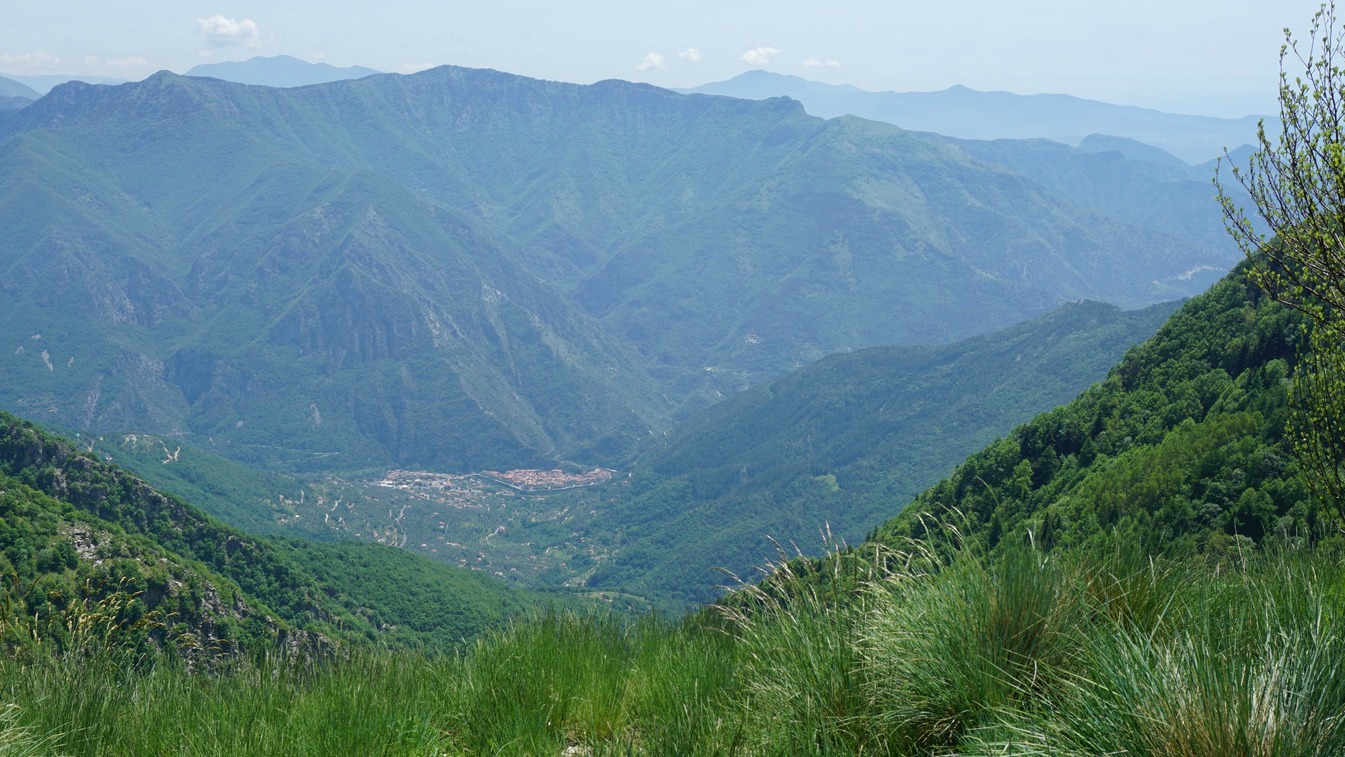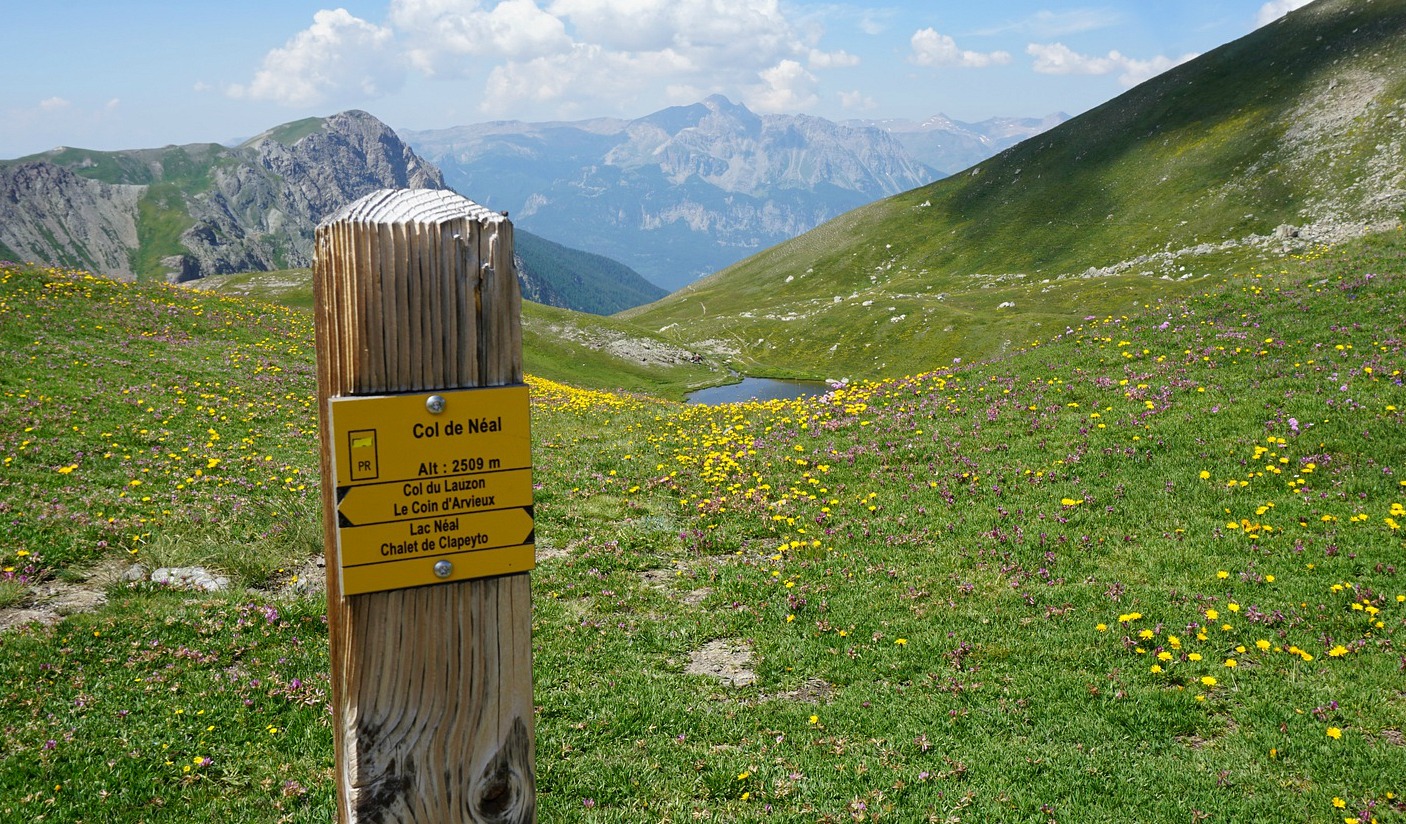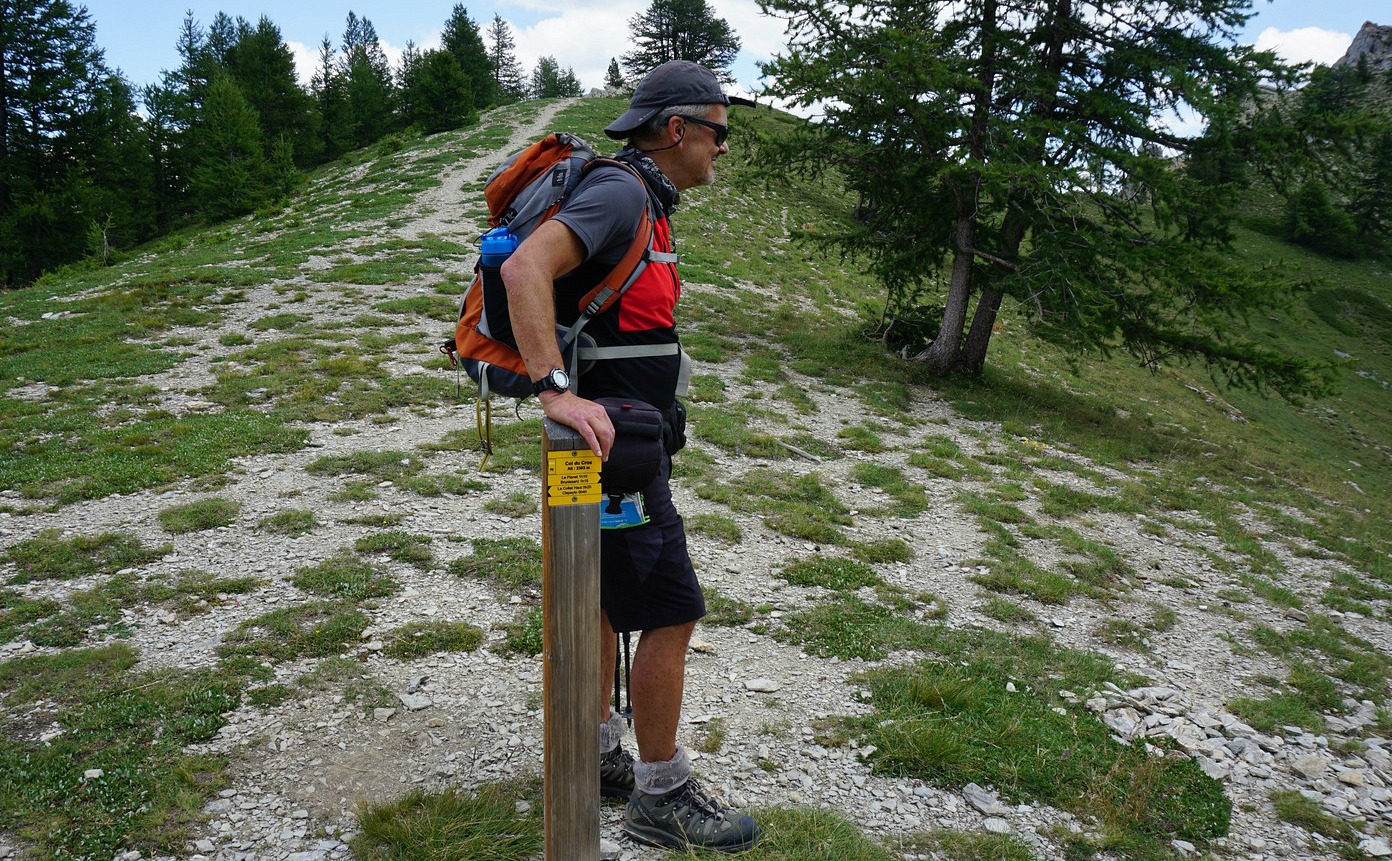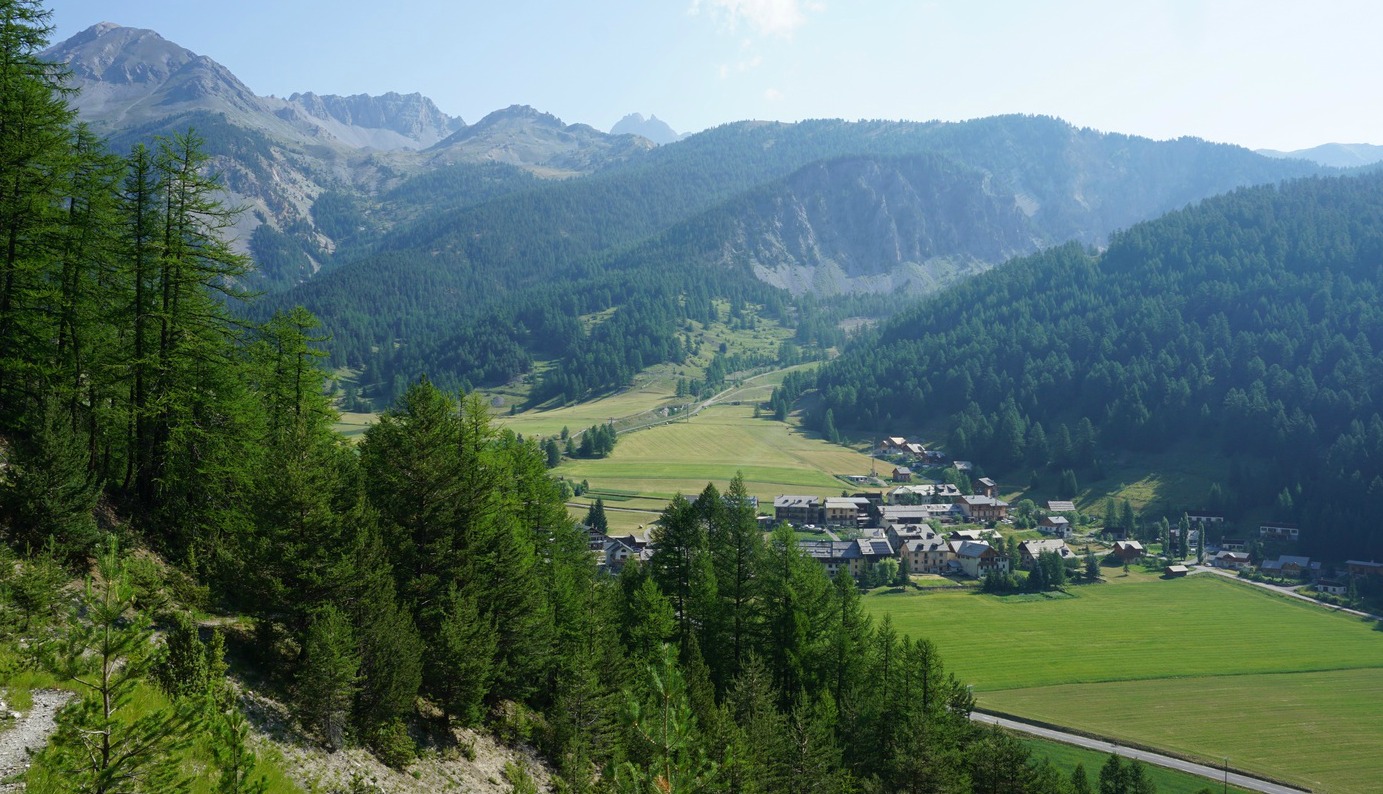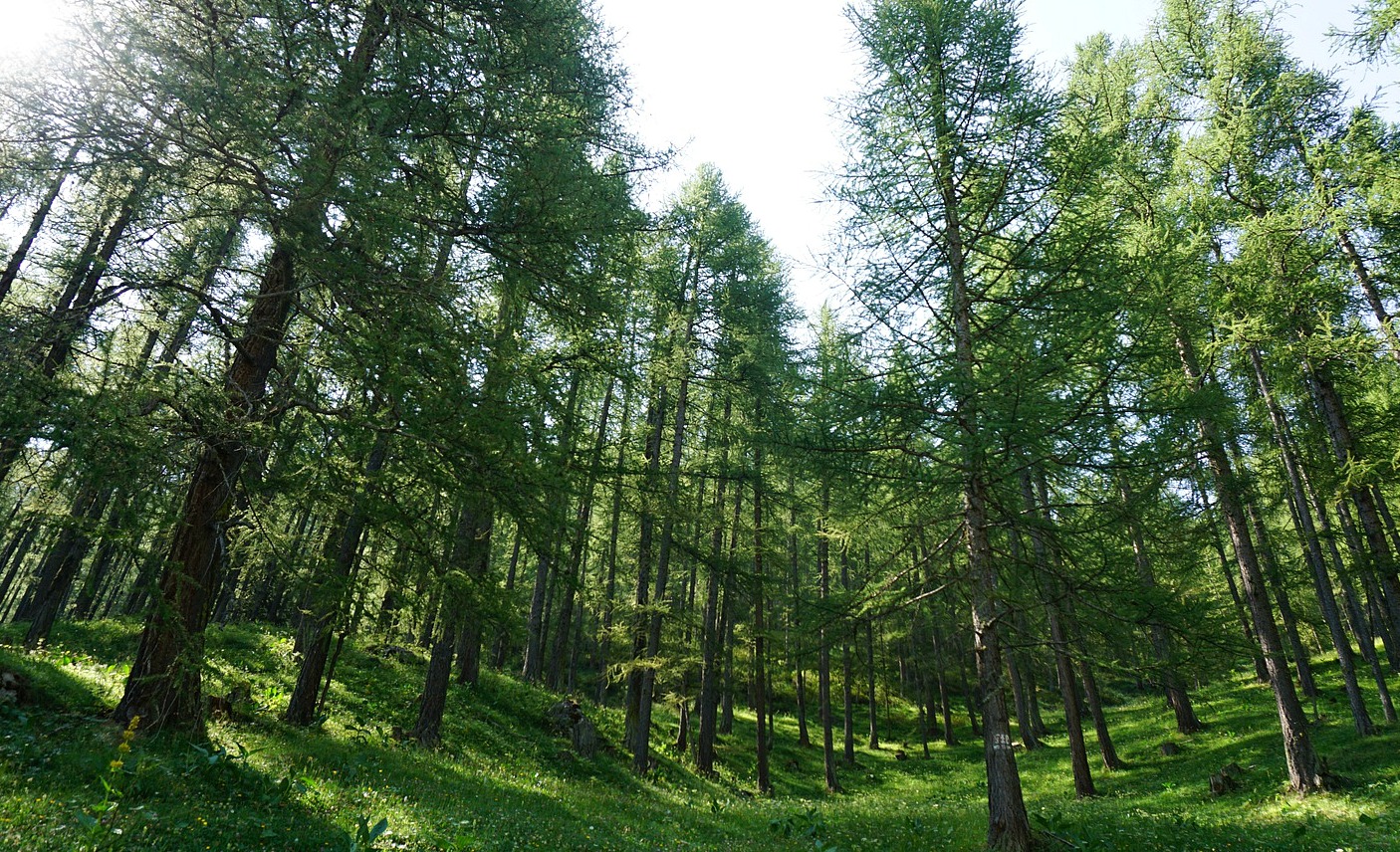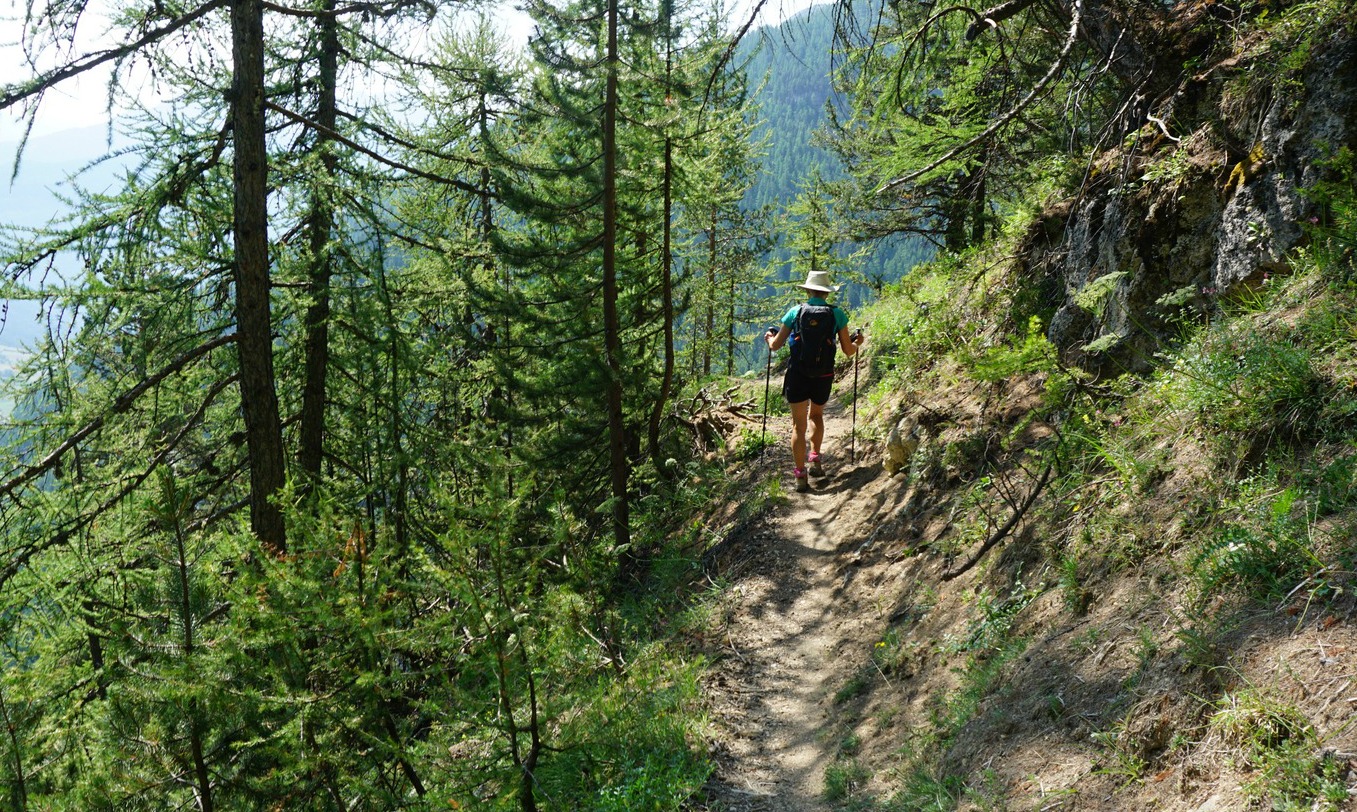
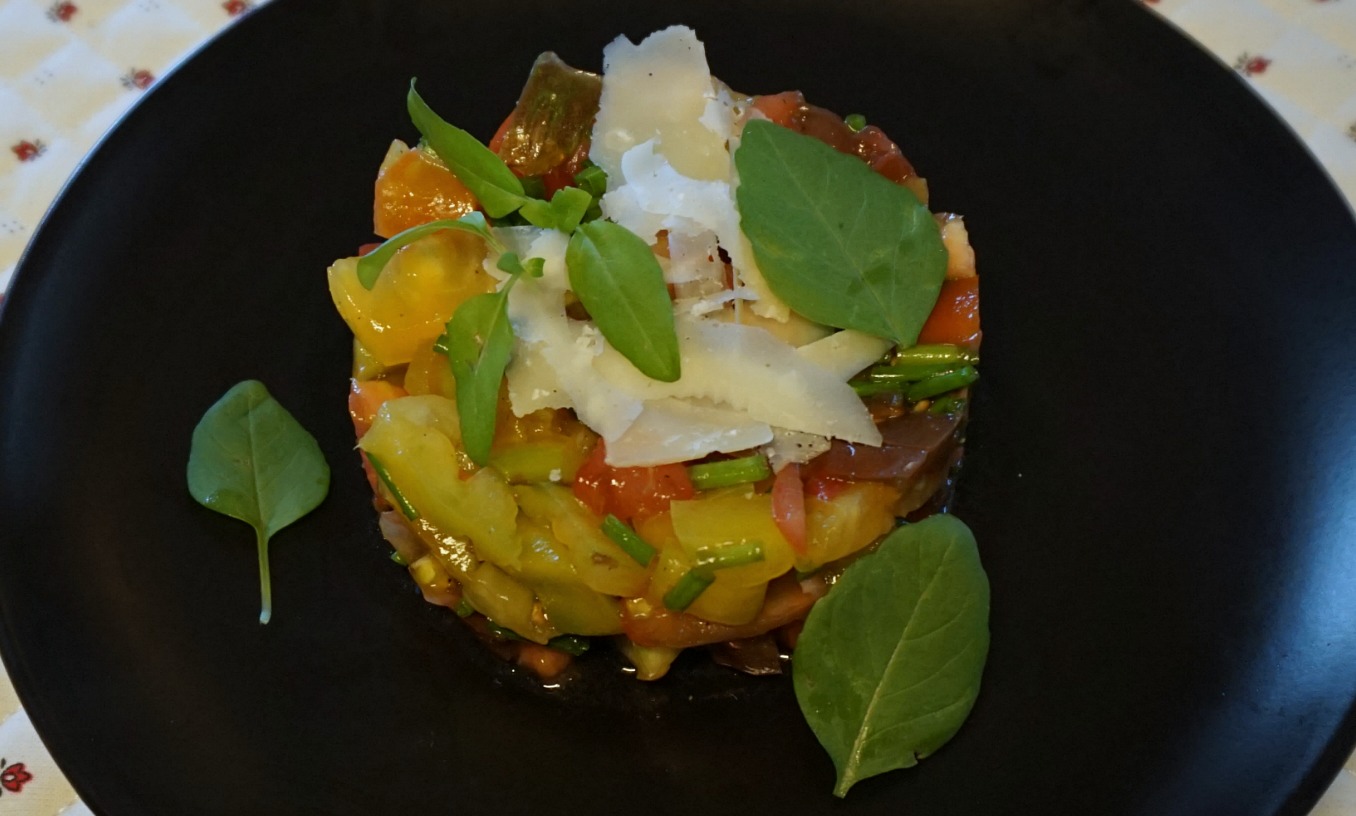
The following simple recipe makes an impressive starter in late summer or early autumn when tomatoes are in season.
2 servings
1 red tomato
1 yellow tomato
1 black tomato
1 tbsp. olive oil
1 tsp red wine vinegar
Chopped chives
Freshly ground black pepper
A few basil leaves
A few shavings of parmesan
Wash and dry the tomatoes. Cut them in small pieces and place for ten minutes in a sieve to release extra liquid. Then place them in a bowl. Add the olive oil, vinegar, black pepper and some chopped chives. Mix and let marinate for a few minutes.
Divide the tartare on the plates with the help of a stainless-steel preparation circle. Decorate with parmesan shavings and basil leaves.

In Alpes-Maritimes, there are several renowned mountain passes on the Franco-Italian border that can be reached by hiking trails, such as Baisse de Druos, Col de Fenestre, Col de Cerise and Pas du Préfouns. This time we wanted to ascend to a lesser known pass above Le Boréon named Col de Frémamorte (2615 m).
Unfortunately, on our given day the weather was more clouds than blue skies. Nevertheless, we had good views down to Italy from the col.
From the Salèse parking (1665 m) above Le Boréon we started ascending along the GR 52 trail towards Col de Salèse (2031 m) which we reached in 1 h 10. From Col de Salèse, we descended a bit then forked right, leaving the GR52, and headed towards Lac Négre, Pas du Préfouns and Col de Frémamorte. We ascended along the popular trail in the forest. Most hikers seemed to continue to Lac Négre. At a crossroads called Camp Soubran (2270 m) and signpost 270, we forked right (east).
Heading east above the tree line, we passed several lakes (Lacs de Frémamorte). The scenery became high-alpine, and the trail rockier.
Approaching the col, we saw remains of a bunker and even an odd ibex. The last push was actually less steep than anticipated as the trail zigzagged in the incline.
In front of us, on the Italian side, we could view the western flank of the imposing Argentera Massif (at 3297 m the highest peak in the Maritime Alps), several lakes below us, and in the distance the lowlands near Cuneo that were covered with low clouds. From the col, one trail descended down to Italy, the other, looking a bit exposed, went up to the nearby summit called Cime de Frémamorte (2730 m).
We descended along the same trail back to our starting point.
Climb: 960 m
Distance: 17 km
Duration: 5h 45 active
Map: IGN 3741 0T Vallée de la Vésubie

When the plums are in season, we eat some dark plums every morning and I also use them in cooking. The following recipe can be made from pitted prunes when the plum season is over.
2 servings
3 tbsp. olive oil
4 organic chicken thighs, with skin
4 large dark plums or pitted prunes
1 small onion, chopped
1 clove garlic, minced
100 ml white wine
2 tbsp. pitted green olives, pref. organic
1 tsp. dried Provençal herbs
Freshly ground black pepper
A glass jar of 250 g cooked white beans
Chopped chives
Preheat the oven to 200° C.
Spread 1 tbsp. olive oil in the bottom of an ovenproof dish. Place the chicken thighs in the dish skin side up.
Arrange the onion, garlic, and olives around the chicken and pour in the wine. Add the black pepper and herbs and sprinkle with 2 tbsp. olive oil. Bake for 30 minutes.
Meanwhile wash the plums, halve them and remove the stones. Rinse the white beans under running water. Add the beans and plums in the dish around the chicken and continue baking for 15 minutes.
Decorate with chopped chives.
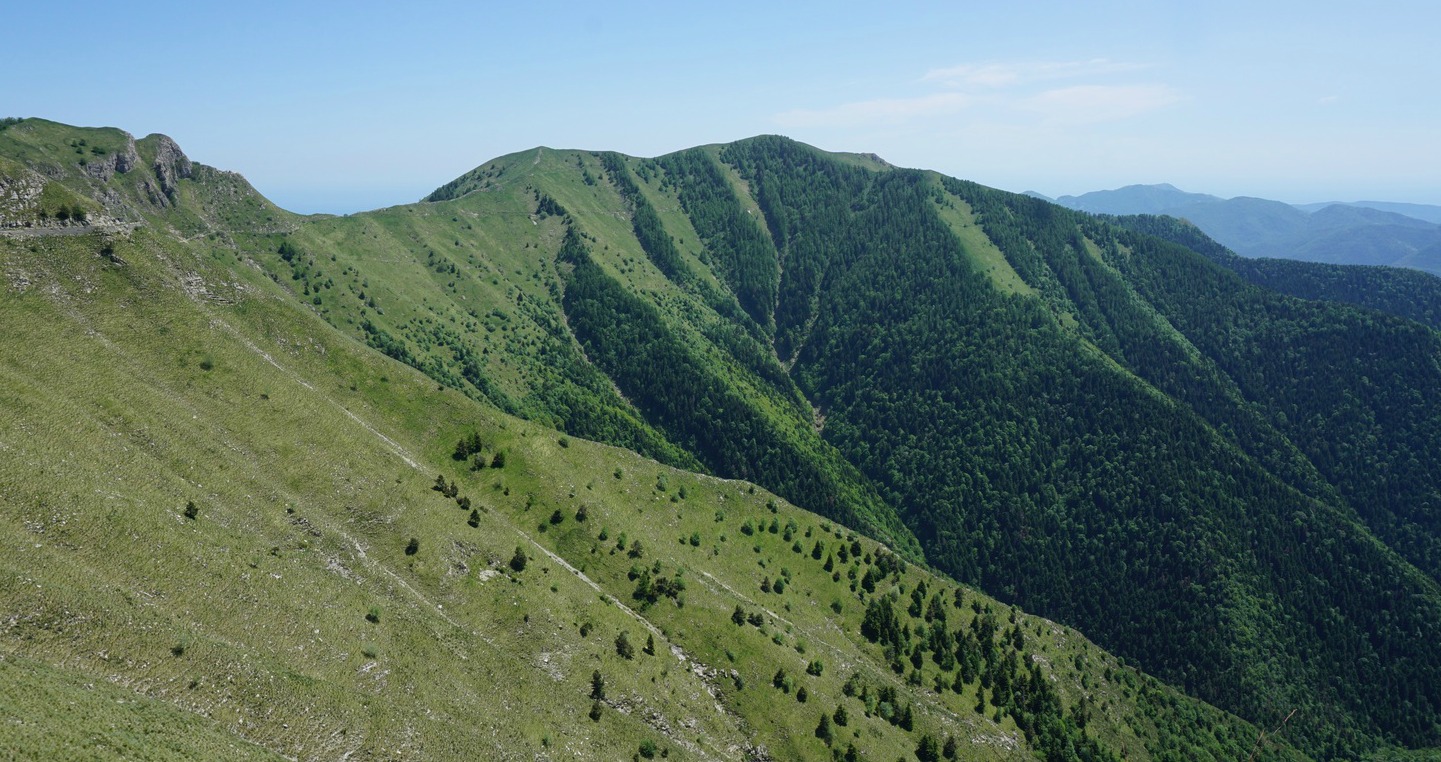
We have twice before tried to reach the summit of Mangiabo (1821 m) from Moulinet, but had to turn around because the weather turned bad.
Mangiabo which is situated inside the southern part of the Mercantour National Park, is only 18 km from the coast as the crow flies. It is also the southernmost major peak in the ridge that stretches south of Authion. Old military installations are omnipresent all along the route. It is possible to use the GR52 hiking trail that runs along the ridge, partly along dirt tracks, partly along good paths to reach Mangiabo. Compared with a route starting from Moulinet deep in the valley, the summit can be reached from Authion with much less vertical ascent.
On our third attempt the weather was favourable. We drove up to Col de Turini, then to Authion where we took the D68 road that circles counterclockwise the area. The road is paved but potholed, so proceed with care. We drove past Cabanes Vieilles and a cattle shelter and parked at the second sharp bend after the shelter.
We headed straight south along a wide dirt track (GR52) as far as to signpost #151 where we continued along a path in the woods marked with white and red i.e. GR colours. We followed the path to Baisse de Ventabren, took the GR52 trail that followed the eastern flank of Pointe de Ventabren to Baisse de la Déa. The ancient military track circles along the western flank, and we took it on the way back.
From Baisse de la Déa the trail ran along the western flank of the ridge, passing several bunkers. This part of the trail under Cime de la Gonella was a bit narrower and somewhat exposed. We passed signpost #142 and 143 and soon came to #144 from where we had an easy final ascent to the grassy summit marked with a cairn.
We had a super 360° panorama of the whole region. In spite of some haze, the Mediterranean, Cap d’Antibes etc were visible in distance, and of course the still snow-capped high peaks in the north.
We used the same itinerary back apart from the dirt track circling along the western flank of Pointe de Ventabren (see our GPS track below).
Total distance: 13 km
Total climb: 576 m
Duration: 3h 50 (active)
Map: IGN 3741 ET Vallées de la Bévéra et des Paillons

The following carefree recipe is full of flavours from the South of France. Red mullet is the Mediterranean choice of small fish fillets for this dish but other small fish fillets could also be used.
Tapenade, black olive paste, is an essential ingredient in the recipe. If you don’t have tapenade in your area, it is easy to make. In a food processor, combine a handful of best-quality pitted black olives, 1 tbsp. capers and 1 tbsp. olive oil. Process into a paste. Add more olive oil if the paste seems dry. The paste does not need to be wholly smooth.
2 servings
About 250 g red mullet fillets
A small jar of tapenade
1 fennel
2- 3 tbsp. olive oil
Two handfuls of baby spinach leaves
A handful of cherry tomatoes
1 garlic clove, minced
Fresh basil leaves
Wash and slice the fennel. Place in a microwave dish with a splash of water and microwave until soft.
Preheat the oven to 200° C.
From baking paper, cut two large pieces, about 40 x 40 cm. Divide the fennel in the centre of the papers and place half of the fish fillets on top. Add a generous teaspoon of tapenade on each red mullet fillet and top with the rest of the fillets. Fold the parcels tightly and bake for 10 minutes.
Meanwhile warm 1 tbsp. olive oil in a large casserole over medium heat and sauté the garlic for a few minutes. Add the spinach and sauté until wilted. This takes only a couple of minutes.
Wash the cherry tomatoes and cut into halves.
When the fish is done, remove the parcels from the oven and place directly n the plates. Open them and arrange the paper nicely. Divide the spinach on the side and scatter the cherry tomato halves on top. Sprinkle with some olive oil and decorate with basil leaves. Serve the parcels with some good country bread.

This hike crosses the Alpine Chalets of Clapeyto. The chalets were built in the beginning of the 19th century. The village men ascended there in the end of July to make hay, then descended back to the valley. The elderly and children arrived in mid-August with the cattle. They stayed up there until the end of September watching over the cattle, milking and making cheese. At the end of the 19th century, this activity was discontinued and shepherds took over.
The trail we describe here passes through the hamlet of Clapeyto. Many of the chalets are now restored and used as summer homes.
From the village of Brunissard (1796 m; just south of Col d’Izoard) we first followed the GR5 trail, passing a camping ground, then continued to Le Pra Premier (2050 m; an alpine meadow en route), still following the dirt road. We continued along GR5 a bit more to a crossroads at l’Eychaillon where we forked left, leaving the GR5 and headed towards the Chalets of Clapeyto. Some of the houses were nicely renovated and occupied. The dirt track ended after the last houses, and the trail proper continued along vast meadows. We headed towards Col de Néal (2509 m).
Before Col de Néal we walked past some small lakes (Lacs du Cogour) and marshes, and first ascended to a signpost named Lacs Marion (2520 m). We continued to nearby Col de Néal where we had Lac de Néal below us.
After a break we continued along the trail towards Col du Lauzon, but forked left (crossroads marked only with a stick of wood) after about 350 m (at 2536 m elev.) and started a steep descent in the valley west of the precipice of Pic de Balart Massif (2736 m). At this point, the return itinerary became more “sauvage” as we proceeded in a north-easterly direction towards le Collet (small huts well below our trail on the left-hand side). We still had another ascent in front of us, namely to Col du Cros (2303 m) before the final long descent to our starting point. The trail first ran in rocky high alpine terrain, then in a larch forest before Brunissard.
Distance: 15 km
Climb: 800 m
Duration: 5h 30 active
Map: 3537 ET Guillestre Vars Risoul

This recipe was inspired by a feature in the French Télématin about the black pig of the Pyrenees. This pig, porc noir de Bigorre, is an ancient breed which was saved in 1980’s. This pig is not suitable for mass rearing methods because it needs a lot of space to roam freely and it grows slowly. The meat has excellent flavour and is in demand in top Parisian restaurants.
The dish was cooked in open air in Hautes- Pyrénées. Because fresh black pig’s meat is not available in our supermarket in Nice, I have replaced it with lean pork tenderloin, filet mignon de porc.
2 servings
About 300- 400 g pork tenderloin, cut into 4 x 4 cm cubes
1 shallot, chopped
1 clove garlic, minced
8- 10 green asparagus spears
3 tbsp. olive oil
3 tbsp. crème fraîche, 15 % fat
Freshly ground black pepper
Fresh herbs to decorate
In a large frying pan, warm olive oil over medium heat. Fry the pork cubes until nicely browned on all sides.
Meanwhile peel the asparagus, discard the tough bottom parts and cut into about 3- 4 cm long pieces. Add the asparagus, shallot, and garlic o the pan and continue sautéing about 10 minutes until the vegetables are soft and the pork is cooked.
Add the black pepper and crème fraîche and mix.
Decorate with fresh herbs and serve with new potatoes or red quinoa.

After two strenuous hiking days, and in the hassle of the day before the Tour de France, we just wanted to make an easy walk, starting directly from our hotel in la Chalp Arvieux (1685 m). Following the GR58 to the picnic area at Cabane du Plan du Vallon seemed like a good idea.
Well, we got a bit more than we wished because the trail down from Crête de l’Echelle (1934 m) was fairly steep and delicate. So never leave for your hikes without hiking poles!
From the parking in la Chalp, we descended a bit, then crossed the dry riverbed and headed south about 100 m, then forked right along a path that soon merged with the GR58.
We continued along GR58, passing a dirt track and a crossroads (Torrent du Combe Bonne 1770 m), then ascended in a magnificent larch forest to Crête de l’Echelle along a good soft trail.
Descending from the Crête along its southern flank, the trail became narrower, rockier and steeper. We passed some rock slides. We came to a crossroads next to the dirt track that went up the valley. Still following the GR markings, we continued ascending along a wider trail for a while, then again along a forest trail, passing a small lake before reaching our goal today. The cabane turned out to be just a tiny hut next to a forest clearing.
On the way back, we used the same trail to the intersection by the bridge, then followed a wide trail towards Arvieux (a GR58 variant trail). At a signpost before Arvieux, however, we forked left, taking the path to le Coin, walked through the village, then ascended back to la Chalp along a track that followed the river.
The image below shows our itinerary.
Distance: 10,6 km
Duration: about 4h 45
Climb: 690 m
















